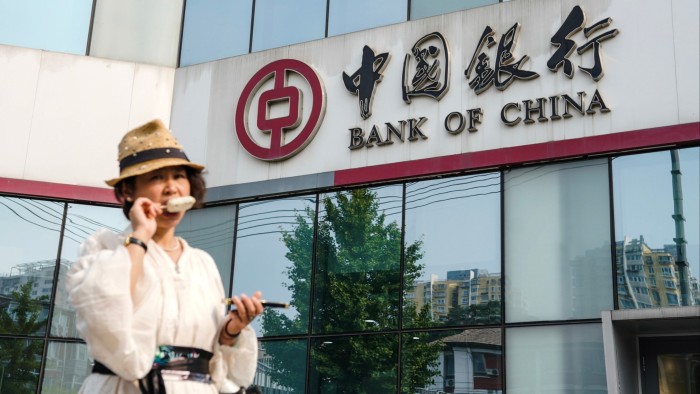Stay informed with free updates
Simply sign up to the Chinese business & finance myFT Digest — delivered directly to your inbox.
Four of China’s biggest banks will raise a combined Rmb520bn ($72bn) through share sales to investors including the Ministry of Finance, as Beijing seeks to shore up its vast banking sector against pressing economic woes.
Bank of China, Bank of Communications, Postal Savings Bank of China and China Construction Bank said they would raise Rmb165bn, Rmb120bn, Rmb130bn and Rmb105bn respectively in stock exchange filings on Sunday.
The Ministry of Finance will be a major investor in the capital raise by the four banks, which are all state-owned and collectively had about Rmb10tn in capital as of last June.
The rare government-directed injections will increase the banks’ core tier one capital — a gauge of equity that regulators use to limit leverage — and are part of a series of official support measures that have since last September aimed to restore confidence in the world’s second-largest economy.
China is grappling with the threat of deflation, weak consumer spending and a property slowdown now well into its fourth year, and policymakers have recently adapted a more urgent tone as they try to restore confidence.
The country’s biggest banks face margin pressure and the capital increase, which was previously flagged by authorities, is part of a push to boost lending amid continued weakness across an economically critical property sector.
Bank of China’s net interest margin — a measure of profitability — fell to 1.4 per cent last year, from 1.59 per cent, while at Bank of Communications it narrowed slightly to 1.27 per cent.
Authorities set a GDP growth target of 5 per cent for 2025 at a meeting of top policymakers this month, where they also pledged to issue Rmb500bn in special bonds to fund the capital injections into the banking sector.
Chinese exports are subject to fresh tariffs from the Trump administration in the US, which were initially an additional 10 per cent in February before being doubled this month to 20 per cent. Exports last year were a driver of growth as falling house prices weighed on consumption.
“The injections would boost the availability of funds to support the country’s growth amid tariff headwinds,” wrote analysts at S&P Global this month. They added that the “megabanks play an important role in supporting the government’s social and economic initiatives via lending to policy promoted areas”.
Policymakers initially signalled a recapitalisation of China’s biggest banks in September last year when Beijing unveiled cuts in mortgage rates and stock market buybacks. The equity market subsequently rebounded after years of declines, with the CSI 300 gauge of Shanghai- and Shenzhen-listed stocks up more than 10 per cent in the past year.
But the property sector is still weighing heavily on confidence, with new home prices declining in February and investment in development down 10 per cent on last year. Chinese property developers have about Rmb12tn of liabilities in total, according to a 2023 estimate from the National Bureau of Statistics.


